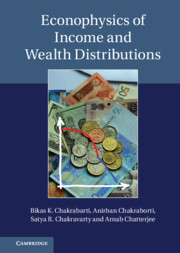Book contents
- Frontmatter
- Contents
- Preface
- 1 Introduction
- 2 Income and wealth distribution data for different countries
- 3 Major socioeconomic modelling
- 4 Market exchanges and scattering process
- 5 Analytic structure of the kinetic exchange market models
- 6 Microeconomic foundation of the kinetic exchange models
- 7 Dynamics: generation of income, inequality and development
- 8 Outlook
- References
- Index
8 - Outlook
Published online by Cambridge University Press: 05 May 2013
- Frontmatter
- Contents
- Preface
- 1 Introduction
- 2 Income and wealth distribution data for different countries
- 3 Major socioeconomic modelling
- 4 Market exchanges and scattering process
- 5 Analytic structure of the kinetic exchange market models
- 6 Microeconomic foundation of the kinetic exchange models
- 7 Dynamics: generation of income, inequality and development
- 8 Outlook
- References
- Index
Summary
Any city, however small, is in fact divided into two, one the city of the
poor, the other of the rich; these are at war with one another.
Plato, ancient Greek philosopher (427–347 BC)Throughout the recorded history of human civilization, we have witnessed the bitter outcomes of economic inequality – social tensions, conflicts, etc. This incessant problem has been addressed by some of the greatest thinkers, philosophers and social scientists, including economists. Questions on the nature of the distributions of wealth and income have been raised repeatedly. More so, during or just after periods of crisis, wars and social calamities. In this book, we have tried to present a new interdisciplinary approach in analysing and dealing with the age-old problem of economic inequality in the societies. This paradigmatic shift has been possible owing to the combined efforts of economists, mathematicians and physicists (Cockshott et al. 2009; Sinha et al. 2010).
Noting that this inequality has a very robust and universal statistical form (discussed extensively in the first two chapters of this book), and the fact that some core human ability factors, such as the intelligence quotient or health factors, are distributed according to the normal (or Poisson, at times) distribution, a natural question to ask is why are the distributions in wealth and income so different from the normal? Why do they have such broad distributions, and with ubiquitous power law tails? The very fact that these distributions have such different characteristics (and are universally observed) indicates that there must be a deeper cause (and a common underlying mechanism).
- Type
- Chapter
- Information
- Econophysics of Income and Wealth Distributions , pp. 193 - 200Publisher: Cambridge University PressPrint publication year: 2013



